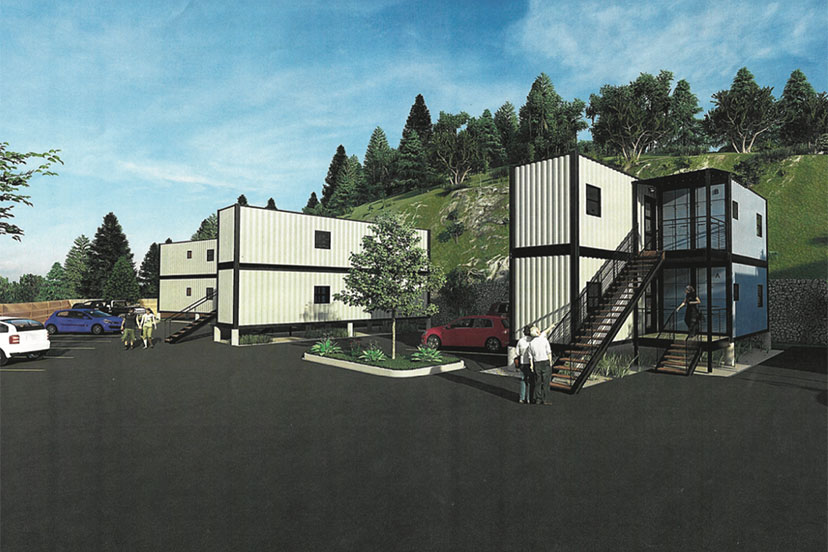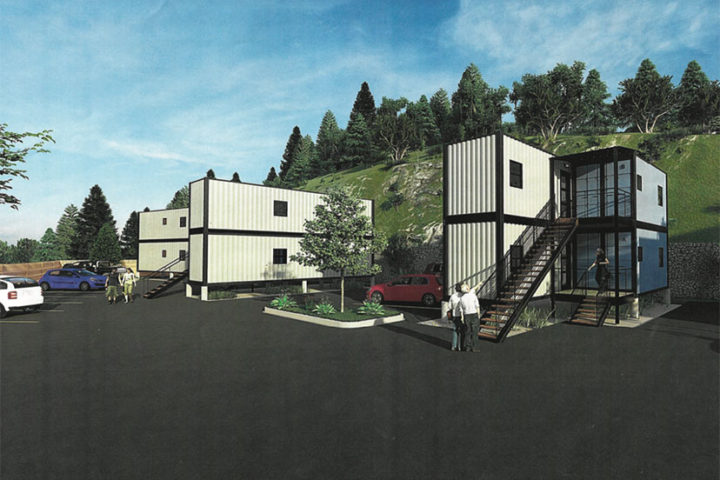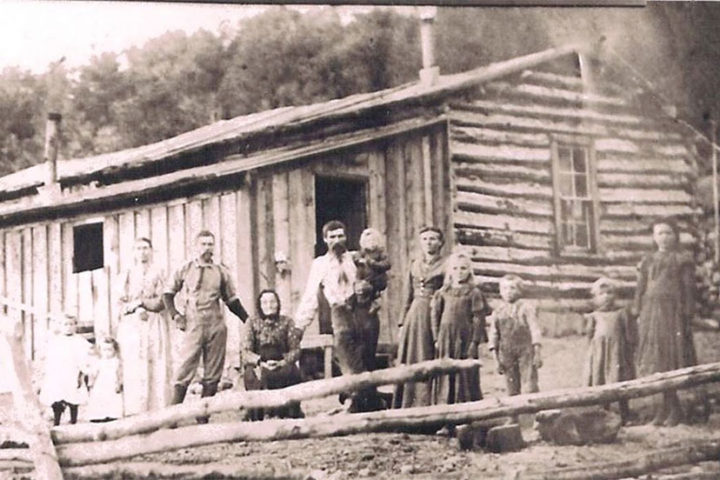Shipping container homes are a great entry point into living in a tiny house. Shipping containers are rugged and durable, built to withstand 100+mile per hour winds, huge waves and long journeys on cargo ships…
— from TheWaywardHome.com
A few folks appear to be upset with a certain Town Planning Commission decision, on April 27, giving preliminary approval for a somewhat unique housing complex proposed for Majestic Drive.
The complex — a collection of four duplex structures built from metal shipping containers — has been proposed by local businessman George Brown. An artist rendering, viewed by Planning Commission prior to the approval, looked like this:
The Town Planning Department had, however, failed to provide sufficient notice for the April 27 public hearing, so the approval hearing has been re-scheduled for the May 25 Planning Commission meeting. Hopefully, everyone with an interest in the long-term viability of the Pagosa Springs community, and with an interest in innovative housing styles, will have an opportunity to attend the meeting, in-person or via Zoom.
This might include persons who are outraged by use of cargo containers to construct duplex apartment units.
One person wrote a letter to the weekly Pagosa Springs SUN, following the previous publication of a news article therein, about the proposed housing complex.
The letter read, in part:
Shipping containers?
If a developer came to me with this proposal I would have signaled our meeting was over within 30 seconds. You do this by standing up and thanking him for stopping by.
Prior to retirement my business required worldwide travel which, by the way loses it’s glamour real fast. One of my more frequent destinations was Hong Kong which in the seventies and eighties was a vibrant, exciting city. They had a major problem however. Where to house the Vietnamese boat people who were pouring in. On one of my trips a friend who was a resident of Hong Kong took me to see where these people were “housed”. In a word, horrific.
When I saw the photo of these shipping containers on the front page of the SUN it was an instant flashback to what I witnessed in Hong Kong where these unfortunate people were kept…
…I have lived in Pagosa for 16 years and am appalled at what our local government will even consider. You people should to be ashamed…
We can easily assume that this particular retired individual lives in a home which was not constructed from metal shipping containers.
It’s possible, however, that our appalled critic lives in… a log cabin? We have quite a few log cabins in Pagosa Springs. Some are modest, and some are not-so-modest.
The log cabin has a long and sometimes romantic history in North America — and in other parts of the world where evergreen trees grow tall and straight. It’s not unusual for certain wealthy people, shopping for a luxurious house in Pagosa Springs, to be specifically looking for a log cabin. On acreage, of course.
But log cabins haven’t always been a symbol of luxury. Quite the contrary. A log cabin, in the history of the American West, was once the most viable type of permanent housing for a community’s poorest residents. Back in the day, a log cabin was a socially-inferior dwelling, just a step above a canvas tent. I believe the next step up from a log cabin, in terms of status, was a stone house.
Because a log cabin was eminently affordable, and could be built by anyone who possessed a sharp axe and a strong back, wealthy folks in the American West, and even middle-class folks, much preferred to build ‘higher status’ homes from sawed lumber — or better yet, out of brick.
We’ve come a considerable ways since European descendants headed west across North America, looking for jobs in the mines, in the sawmills, on ranches and farms, in schools and government offices. Many of them built and lived in log cabins, until they could afford something more ‘desirable’.
But times change, and tastes change.
We’ve seen the lowly “log cabin” become the highly-sought-after “log cabin.”

The folks who stock the retail shelves and make the hotel beds and serve the restaurant patrons here in Pagosa Springs… well, they no longer live in log cabins. They’re lucky, in fact, if they have any place to call home. Some are living in nylon tents. (A step below canvas tents, perhaps.) Others are living in our modern version of the poor man’s log cabin: the mobile home.
In one sense at least, a shipping container is related to a mobile home. Both are intended to be transported, unlike most other types of dwellings. (Nylon and canvas tents are also convenient to transport.) But unlike mobile homes — and log homes, and other types of housing — shipping containers are currently in rather abundant supply.
During a one-month period between January 21, 2020 and February 21, 2020, about 465,000 shipping containers arrived in the US from China. That suggests perhaps 5.6 million containers arriving each year — from one (large) Asian country. But for every 100 containers that show up in North America, only 40 make their way back to Asia. That means 60 percent of the containers shipped to North America are currently accumulating in places where they remain unused.
When we consider the amount of cargo that ships to the US from Asia, the numbers are… well… staggering. In 2021, shipping containers are much more readily available than tall, straight, pine trees. Maybe not in a forested locality like Archuleta, but certainly in most of the US.
So let’s dig a bit deeper into George Brown’s proposal, and see why the Town Planning Commission unanimously approved this project. And what the future might hold.



